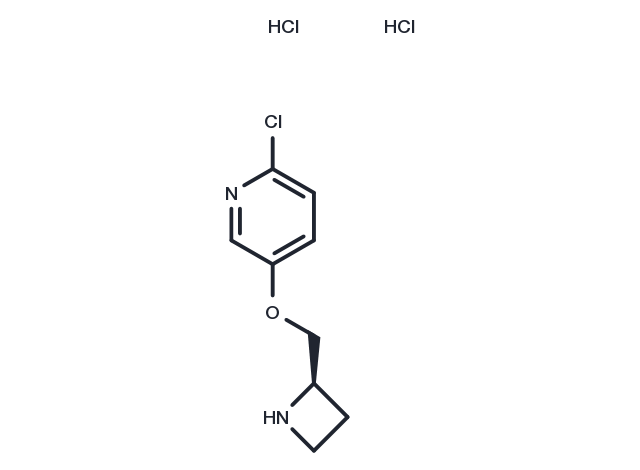Powder: -20°C for 3 years | In solvent: -80°C for 1 year


Tebanicline dihydrochloride (Ebanicline dihydrochloride) is a nAChR modulator with effective orally analgesic activity. Tebanicline dihydrochloride inhibits the cytisine binding to α4β2 neuronal nAChRs with a Ki of 37 pM [1].

| Pack Size | Availability | Price/USD | Quantity |
|---|---|---|---|
| 2 mg | 5 days | $ 49.00 | |
| 1 mL * 10 mM (in DMSO) | 5 days | $ 96.00 |
| Description | Tebanicline dihydrochloride (Ebanicline dihydrochloride) is a nAChR modulator with effective orally analgesic activity. Tebanicline dihydrochloride inhibits the cytisine binding to α4β2 neuronal nAChRs with a Ki of 37 pM [1]. |
| In vitro | Tebanicline is a novel and effective cholinergic nAChR ligand with analgesic properties and preferential selectivity for neuronal nAChRs. Tebanicline inhibits the binding of cytisine to α4β2 neuronal nAChRs with a Ki of 37 pM. Tebanicline is functionally an agonist. At the transfected human alpha 4 beta 2 neuronal nAChR (K177 cells), with increased 86Rb+ efflux as a measure of cation efflux, Tebanicline had an EC50 value of 140 nM with an intrinsic activity (IA) compared with (-)-nicotine of 130%; at the nAChR subtype expressed in IMR-32 cells (sympathetic ganglion-like), an EC50 of 340 nM (IA = 126%); at the F11 dorsal root ganglion cell line (sensory ganglion-like), an EC50 of 1220 nM (IA = 71%); and via direct measurement of ion currents, an EC50 value of 56,000 nM (IA = 83%) at the human alpha 7 homooligimeric nAChR produced in oocytes. |
| In vivo | Tebanicline is a potent analgesic with full efficacy in models of acute and persistent pain and these effects are primarily mediated by an action at central neuronal nAChRs [2]. Tebanicline produces significant analgesic effects in mice in response to acute noxious thermal stimulation. ABT-594 is orally active, but 10-fold less potent by this route than after intraperitoneal injection. The analgesic effect of ABT-594 is blocked, but not reversed, by the noncompetitive neuronal nicotinic acetylcholine receptor antagonist [3]. Tebanicline has analgesic effects in rat models of acute thermal, persistent chemical, and neuropathic pain. Injection of tebanicline directly into the nucleus raphe magnus (NRM) is antinociceptive in a thermal threshold test and disruption of serotonergic neurons in the NRM attenuates the effect of systemic tebanicline [4]. |
| Molecular Weight | 271.57 |
| Formula | C9H13Cl3N2O |
| CAS No. | 209326-19-2 |
Powder: -20°C for 3 years | In solvent: -80°C for 1 year
You can also refer to dose conversion for different animals. More
bottom
Please see Inhibitor Handling Instructions for more frequently ask questions. Topics include: how to prepare stock solutions, how to store products, and cautions on cell-based assays & animal experiments, etc.
Tebanicline dihydrochloride 209326-19-2 inhibitor inhibit
